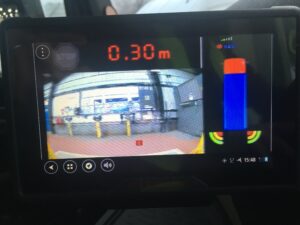Road safety
How to prevent slow speed manoeuvring incidents
Mark Pawsey, UKI Distribution Manager at Air Products, discusses why incidents that occur at slow speeds can be just as dangerous as those at speed and explains the measures that Air Products has taken to introduce a preventative approach.
 Being aware of your surroundings is always critical, no matter if you’re walking in the street, talking while on a train or driving a vehicle. But while the need to concentrate and take regular breaks when driving at speed have been well publicised, there is generally less focus on the risks associated with slow manoeuvring. The reality, however, is that when we reduce speed, or reach a familiar location, we are more likely to go into autopilot and let our minds wander.
Being aware of your surroundings is always critical, no matter if you’re walking in the street, talking while on a train or driving a vehicle. But while the need to concentrate and take regular breaks when driving at speed have been well publicised, there is generally less focus on the risks associated with slow manoeuvring. The reality, however, is that when we reduce speed, or reach a familiar location, we are more likely to go into autopilot and let our minds wander.
According to the Health and Safety Executive, about 70 people are killed and 2,000 are seriously injured in accidents involving vehicles in and around workplaces each year – which is 2,070 too many. Interestingly, the Department for Transport (DfT) revealed that fatalities specifically related to slow driving were increasing; figures from 2019 showed that two people were killed, and 26 people were seriously injured in incidents where slow driving was a contributing factor. It’s clear that even though slow speeds are rarely the cause of an accident, they can sometimes lead to a more dangerous scenario.
Ensuring the safety of our drivers, customers, vulnerable road users and the general public is paramount at all times, but the scale of our operation and the potentially hazardous materials we’re transporting makes it more challenging – we deliver industrial gas to almost 10,000 customers across the UK each year, ranging from large industrial facilities to small leisure environments. With this in mind, we continually review our safety procedures to find ways to make improvements. It was during one of these assessments of our fleet’s accident and collision data that we identified that slow manoeuvring incidents made up around 85% of our preventable vehicle accidents.
Reduce the risks
 At Air Products, we have an aim of being the safest industrial gas company with an objective of zero accidents and incidents, and a philosophy that all accidents are preventable. This goal may be ambitious, but it is the only target which we consider acceptable. So, after seeing our benchmark data, we set ourselves a challenge to reduce the risks associated with slow-speed manoeuvring – whether in tight loading and unloading points or when navigating busy city centres.
At Air Products, we have an aim of being the safest industrial gas company with an objective of zero accidents and incidents, and a philosophy that all accidents are preventable. This goal may be ambitious, but it is the only target which we consider acceptable. So, after seeing our benchmark data, we set ourselves a challenge to reduce the risks associated with slow-speed manoeuvring – whether in tight loading and unloading points or when navigating busy city centres.
To reduce the number of incidents we trialled various options, before developing and installing a bespoke collision warning solution consisting of multiple sensors, cameras and verbal warnings within one system. This included four proximity sensors on the left side of the rigid cabin and in the tractor units, giving coverage of the usual ‘blind spot’ area, in addition to a reversing camera and up to six proximity sensors on the rear of the vehicle / trailer. Two cameras were also fixed on both sides of the rigid cabin or tractor unit, providing wide angle visibility of both sides of the vehicle during left and right turn manoeuvres; and one left turn announcer was installed to warn pedestrians and vulnerable road users when the vehicle is turning (it can also be muted between 11pm-7am, so as not to cause disruption to local residents).
The introduction of this bespoke solution offers our drivers the use of the best technology aids available when manoeuvring vehicles at slow speeds. The system transfers data and images down existing power lines, so there’s no need for additional Susie cables from tractor to trailer. This is particularly key as it means our drivers don’t need to remember to connect any extra cables or pair any devices, removing any risk of user error. In addition, we used an existing navigation display screen to show the reverse camera image when reversing or the side view when indicating – safely providing all the information on one focal point, rather than across multiple screens, which could be distracting to the drivers.
Collision warning system

We tested this bespoke collision warning system on 20 vehicles, which included tractors, trailers and rigids, over a six-month period. During this trial, there were no slow speed manoeuvring incidents involving these vehicles. This was a significant reduction from the results highlighted in our pre-trial analysis of preventable vehicle accidents – where approximately 85% of these took place during slower manoeuvring – and is a clear demonstration of the positive effect the system has had.
This technology has also enhanced our Data Enabled Driver Coaching programme, where all drivers have an assigned coach who works with them, using an app to discuss and improve their driving style. If the driver has ‘an event’, their coach receives a notification by email and phone, enabling them to view the video footage captured from the vehicle and take steps to coach the driver accordingly.
Additional challenges
The trial, which took place between June 2019 and May 2020, also faced an additional and unexpected challenge – driving in lockdown and a pandemic. Initially it wasn’t clear which sectors or companies were classed as providing a key or essential service, and access to appropriate break facilities and hot food became an issue. This had the potential to increase levels of fatigue and reduce concentration, but it was quickly resolved and – as one of the Government’s critical gas suppliers – our teams were allowed to continue business as usual with access to the catering and rest-points they needed.
After the success of the trial, we began the process of extending this system to cover our entire UK and Ireland fleet, investing £768,000 in the safe operation of our vehicles. We’re proud of the positive response we’ve received from our drivers, who have been supportive throughout. They recognise that the technology has helped them to become even more aware of hazards in their blind spot, but also to be more conscious of stationary and moving objects, while helping other people on the road to be more aware of the vehicle.
This trial has also reiterated the importance and benefits of fitting additional sensors onto vehicles, specifically focused on preventing slow speed incidents. Clearly, driving at a slower rate and in a smaller space doesn’t mean it’s any safer than driving at 70mph on a motorway, so it was the right decision for us to investigate how we could make our drivers even safer behind the wheel.
We believe that maximising the use of technology and data analysis across all aspects of our drivers’ activities makes the landscape safer for everyone – our drivers, customers, vulnerable road users and the general public – and moves us closer to our ultimate goal of zero accidents and incidents. Our drivers have continued to operate high levels of safety and efficiently throughout the pandemic, achieving an average safety record of 99.99% – but there is always room for improvement. For example, we’re currently operating and tracking against ‘Earned Recognition’ standards, where we continuously monitor our compliance with a set of Key Performance Indicators using a Driver and Vehicle Standards Agency (DVSA) validated IT system. As a result, we have been compliant with vehicle and road safety standards for the past 13 International Organization for Standardization (ISO) periods, and are meeting the DVSA’s stringent driver and vehicle standards. Safety is our core priority and an area we’re always seeking to improve on, no matter how high our results are.
How to prevent slow speed manoeuvring incidents
Mark Pawsey, UKI Distribution Manager at Air Products, discusses why incidents that occur at slow speeds can be just as dangerous as those at speed and explains the measures that Air Products has taken to introduce a preventative approach.
Safety & Health Practitioner
SHP - Health and Safety News, Legislation, PPE, CPD and Resources Related Topics
Horticulture company fined after lorry driver suffers life changing injuries
Drug and alcohol testing in a UK airport environment
Unleashing the power of emerging technologies in EHS

 Being aware of your surroundings is always critical, no matter if you’re walking in the street, talking while on a train or driving a vehicle. But while the need to concentrate and take regular breaks when driving at speed have been well publicised, there is generally less focus on the risks associated with slow manoeuvring. The reality, however, is that when we reduce speed, or reach a familiar location, we are more likely to go into autopilot and let our minds wander.
Being aware of your surroundings is always critical, no matter if you’re walking in the street, talking while on a train or driving a vehicle. But while the need to concentrate and take regular breaks when driving at speed have been well publicised, there is generally less focus on the risks associated with slow manoeuvring. The reality, however, is that when we reduce speed, or reach a familiar location, we are more likely to go into autopilot and let our minds wander. At Air Products, we have an aim of being the safest industrial gas company with an objective of zero accidents and incidents, and a philosophy that all accidents are preventable. This goal may be ambitious, but it is the only target which we consider acceptable. So, after seeing our benchmark data, we set ourselves a challenge to reduce the risks associated with slow-speed manoeuvring – whether in tight loading and unloading points or when navigating busy city centres.
At Air Products, we have an aim of being the safest industrial gas company with an objective of zero accidents and incidents, and a philosophy that all accidents are preventable. This goal may be ambitious, but it is the only target which we consider acceptable. So, after seeing our benchmark data, we set ourselves a challenge to reduce the risks associated with slow-speed manoeuvring – whether in tight loading and unloading points or when navigating busy city centres.